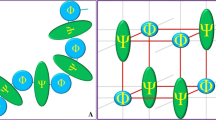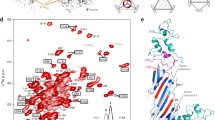Abstract
Hydration shells of normal proteins display regions of highly structured water as well as patches of less structured bulk-like water. Recent studies suggest that isomers with larger surface densities of patches of bulk-like water have an increased propensity to aggregate. These aggregates are toxic to the cellular environment. Hence, the early detection of these toxic deposits is of paramount medical importance. We show that various morphological states of association of such isomers can be differentiated from the normal protein background based on the characteristic partition between bulk, caged, and surface hydration water and the magnetic resonance (MR) signals of this water. We derive simple mathematical equations relating the compartmentalization of water to the local hydration fraction and the packing density of the newly formed molecular assemblies. Then, we employ these equations to predict the MR response of water constrained by protein aggregation. Our results indicate that single units and compact aggregates that contain no water between constituents induce a shift of the MR signal from normal protein background to values in the hyperintensity domain (bright spots), corresponding to bulk water. In contrast, large plaques that cage significant amounts of water between constituents are likely to generate MR responses in the hypointensity domain (dark spots), typical for strongly correlated water. The implication of these results is that amyloids can display both dark and bright spots when compared to the normal gray background tissue on MR images. In addition, our findings predict that the bright spots are more likely to correspond to amyloids in their early stage of development. The results help explain the MR contrast patterns of amyloids and suggest a new approach for identifying unusual protein aggregation related to disease.





Similar content being viewed by others
References
Makarov, V.A., Andrews, B.K., Smith, P.E., Pettitt, B.M.: Residence times of water molecules in the hydration sites of myoglobin. Biophys. J. 79, 2966–2974 (2000)
Fenimore, P.W., Frauenfelder, H., McMahon, B.H., Parak, F.G.: Slaving: solvent fluctuations dominate protein dynamics and functions. Proc. Natl. Acad. Sci. U. S. A. 99, 16047–16051 (2002). doi:10.1073/pnas.212637899
Pal, S.K., Peon, J., Zewail, A.H.: Biological water at the protein surface: dynamical solvation probed directly with femtosecond resolution. Proc. Natl. Acad. Sci. U. S. A. 99, 1763–1768 (2002). doi:10.1073/pnas.042697899
Bhattacharyya, S.M., Wang, Z.-G., Zewail, A.H.: Dynamics of water near a protein surface. J. Phys. Chem. B 107, 13218–13228 (2003). doi:10.1021/jp030943t
Despa, F., Fernández, A., Berry, R.S.: Dielectric modulation of biological water. Phys. Rev. Lett. 93, 228104 (2004). doi:10.1103/PhysRevLett.93.228104
Modig, K., Liepinsh, E., Otting, G., Halle, B.: Dynamics of protein and peptide hydration. J. Am. Chem. Soc. 126, 102–114 (2004). doi:10.1021/ja038325d
Russo, D., Murarka, R.K., Copley, J.R., Head-Gordon, T.: Molecular view of water dynamics near model peptides. J. Phys. Chem. B 109, 12966–12975 (2005). doi:10.1021/jp051137k
Despa, F.: Biological water, its vital role in macromolecular structure and function. Ann. N. Y. Acad. Sci. 1066, 1–11 (2005). doi:10.1196/annals.1363.023
De Simone, A., Dodson, G.G., Verma, C.S., Zagari, A., Fraternali, F.: Prion and water: tight and dynamical hydration sites have a key role in structural stability. Proc. Natl. Acad. Sci. U. S. A. 102, 7535–7540 (2005). doi:10.1073/pnas.0501748102
Li, T., Hassanali, A.A., Kao, Y.T., Zhong, D., Singer, S.J.: Hydration dynamics and time scales of coupled water-proton fluctuations. J. Am. Chem. Soc. 129, 3376–3382 (2007). doi: 10.1021/ja0685957
Despa, F., Berry, R.S.: The origin of long range attraction between hydrophobes in water. Biophys. J. 92, 373–378 (2007). doi:10.1529/biophysj.106.087023
De Simone, A., Zagari, A., Derreumaux, P.: Structural and hydration properties of the partially unfolded states of the prion protein. Biophys. J. 93, 1284–1292 (2007). doi:10.1529/biophysj.107.108613
Frauenfelder, H., Fenimore, P.W., Young, R.D.: Protein dynamics and function: insights from the energy landscape and solvent slaving. IUBMB Life 16, 669–678 (2007)
Ball, P.: Water as an active constituent in cell biology. Chem. Rev. 108, 74–108 (2008). doi:10.1021/cr068037a
Fernández, A., Berry, R.S.: Extent of hydrogen-bond protection in folded proteins: a constraint on packing architectures. Biophys. J. 83, 2475–2481 (2002)
Fernández, A., Berry, R.S.: Molecular dimension explored in evolution to promote proteomic complexity. Proc. Natl. Acad. Sci. U. S. A. 101(101), 13460–13465 (2004). doi:10.1073/pnas.0405585101
Fernández, A., Scott, R., Berry, R.S.: The nonconserved wrapping of conserved protein folds reveals a trend towards increasing connectivity in proteomic networks. Proc. Natl. Acad. Sci. U. S. A. 101, 2823–2827 (2004). doi:10.1073/pnas.0308295100
Fernández, A.; Scott, R.; Berry, R.S.: Packing defects as selective switches for drug-based protein inhibitors. Proc. Natl. Acad. Sci. U. S. A. 103(2), 323–328 (2006)
Denisov, V.P., Halle, B.: Thermal denaturation of ribonuclease A characterized by water 17O and 2H magnetic relaxation dispersion. Biochemistry 37, 9595–9604 (1998). doi:10.1021/bi980442b
Denisov, V.P., Halle, B.: Hydration of denatured and molten globule proteins. Nat. Struct. Biol. 6, 253–260 (1999). doi:10.1038/6692
Chalikian, T.V., Totrov, M., Abagyan, R., Breslauer, K.J.: The hydration of globular proteins as derived from volume and compressibility measurements: cross correlating thermodynamic and structural data. J. Mol. Biol. 260, 588–603 (1996). doi:10.1006/jmbi.1996.0423
Jaeger, H.M., Nagel, S.R.: Physics of the granular state. Science 255, 1523–1531 (1992). doi:10.1126/science.255.5051.1523
Makhatadze, G., Privalov, P.A.: Energetics of protein structure. Adv. Protein Chem. 47, 307–425 (1995). doi:10.1016/S0065-3233(08)60548-3
Petukhov, M., Rychkov, G., Firsov, L., Serrano, L.: H-bonding in protein hydration revisited. Protein Sci. 13, 2120–2129 (2004). doi:10.1110/ps.04748404
Reiss, H.: Scaled particle methods in the statistical thermodynamics of fluids. Adv. Chem. Phys. 9, 1–84 (1965). doi:10.1002/9780470143551.ch1
Fernández, A.: What factor drives the fibrillogenic association of beta-sheets. FEBS Lett. 579, 6635–6640 (2005). doi:10.1016/j.febslet.2005.10.058
Zimmerman, J.R., Brittin, W.E.: Nuclear magnetic resonance studies in multiple phase systems: lifetime of a water molecule in an absorbing phase on silica gel. J. Phys. Chem. 6, 1328–1333 (1957). doi:10.1021/j150556a015
Bryant, R.G.: The dynamics of water–protein interactions. Annu. Rev. Biophys. Biomol. Struct. 25, 29–53 (1996). doi:10.1146/annurev.bb.25.060196.000333
Denisov, V.P., Peters, J., Horlein, H.D., Halle, B.: Using buried water molecules to explore the energy landscape of proteins. Nat. Struct. Biol. 3, 505–509 (1996). doi:10.1038/nsb0696-505
Foster, K.R., Resing, H.A., Garroway, A.N.: Bounds on “bound water”: transverse nuclear magnetic resonance relaxation in barnacle muscle. Science 194, 324–326 (1976). doi:10.1126/science.968484
Perutz, M.F., Finch, J.T., Berriman, J., Lesk, A.: Amyloid fibers are water-filled nanotubes. Proc. Natl. Acad. Sci. U. S. A. 99, 5591–5595 (2002). doi:10.1073/pnas.042681399
Kishimoto, A., Hasegawa, K., Suzuki, H., Taguchi, H., Namba, K., Yoshida, M.: β-Helix is a likely core structure of yeast prion Sup35 amyloid fibers. Biochem. Biophys. Res. Commun. 315, 739–745 (2004). doi:10.1016/j.bbrc.2004.01.117
Petkova, A.T., Leapman, R.D., Guo, Z.H., Yau, W.M., Mattson, M.P., Tycko, R.: Self-propagating, molecular-level polymorphism in Alzheimer’s β-amyloid fibrils. Science 307, 262–265 (2005). doi:10.1126/science.1105850
Nelson, R., Sawaya, M.R., Balbirnie, M., Madsen, A.Ø., Riekel, C., Grothe, R., Eisenberg, D.: Structure of the cross-β spine of amyloid-like fibrils. Nature 435, 773–778 (2005). doi:10.1038/nature03680
Paravastu, A.K., Petkova, A.T., Tycko, R.: Polymorphic fibril formation by residues 10–40 of the Alzheimer’s beta-amyloid peptide. Biophys. J. 90, 4618–4629 (2006). doi:10.1529/biophysj.105.076927
Meersman, F., Dobson, C.M.: Probing the pressure–temperature stability of amyloid fibrils provides new insights into their molecular properties. Biochim. Biophys. Acta 1764, 452–460 (2006)
Benveniste, H., Einstein, G., Kim, K.R., Hulette, C., Johnson, G.A.: Detection of neuritic plaques in Alzheimer’s disease by magnetic resonance microscopy. Proc. Natl. Acad. Sci. U. S. A. 96, 14079–14084 (1999). doi:10.1073/pnas.96.24.14079
Lee, S.P., Falangola, M.F., Nixon, R.A., Duff, K., Helpern, J.A.: Visualization of beta-amyloid plaques in a transgenic mouse model of Alzheimer’s disease using MR microscopy without contrast reagents. Magn. Reson. Med. 52, 538–544 (2004). doi:10.1002/mrm.20196
Jack, C.R. Jr., Garwood, M., Wengenack, T.M., Borowski, B., Curran, G.L., Lin, J., Adriany, G., Grohn, O.H., Grimm, R., Poduslo, J.F.: In vivo visualization of Alzheimer’s amyloid plaques by magnetic resonance imaging in transgenic mice without a contrast agent. Magn. Reson. Med. 52, 1263–1271 (2004). doi:10.1002/mrm.20266
Jack, C.R. Jr., Wengenack, T.M., Reyes, D.A., Garwood, M., Curran, G.L., Borowski, B.J., Lin, J., Preboske, G.M., Holasek, S.S., Adriany, G., Poduslo, J.F.: In vivo magnetic resonance microimaging of individual amyloid plaques in Alzheimer’s transgenic mice. J. Neurosci. 25, 10041–10048 (2005). doi:10.1523/JNEUROSCI.2588-05.2005
Vanhoutte, G., Dewachter, I., Borghgraef, P., Van Leuven, F., Van der Linden, A.: Noninvasive in vivo MRI detection of neuritic plaques associated with iron in APP[V717I] transgenic mice, a model for Alzheimer’s disease. Magn. Reson. Med. 53, 607–613 (2005). doi:10.1002/mrm.20385
Selenko, P., Serber, Z., Gadea, B., Ruderman, J., Wagner, G.: Quantitative NMR analysis of the protein G B1 domain in Xenopus laevis egg extract and intact oocytes. Proc. Natl. Acad. Sci. U. S. A. 103, 11904–11909 (2006). doi:10.1073/pnas.0604667103
Charlton, L.M., Pielak, G.J.: Peeking into living eukaryotic cells with high-resolution NMR. Proc. Natl. Acad. Sci. U. S. A. 103, 11817–11818 (2006). doi:10.1073/pnas.0605297103
Urbanc, B., Cruz, L., Yun, S., Buldyrev, S.V., Bitan, G., Teplow, D.B., Stanley, H.E.: In silico study of amyloid β-protein folding and oligomerization. Proc. Natl. Acad. Sci. U. S. A. 101, 17345–17350 (2004). doi:10.1073/pnas.0408153101
Buchete, N.-V., Tycko, R., Hummer, G.: Molecular dynamics simulations of Alzheimer’s β-amyloid protofilaments. J. Mol. Biol. 353, 804–821 (2005)
Cox, D.L., Sing, R.R.P., Yang, S.: Prion disease: exponential growth requires membrane binding. Biophys. J. 90, L77–L79 (2006). doi:10.1529/biophysj.106.081703
Zheng, J., Jang, H., Ma, B., Nussinov, R.: Annular structures as intermediates in fibril formation of Alzheimer Aβ 17 − 42. J. Phys. Chem. B 112, 6856–6865 (2008). doi:10.1021/jp711335b
Despa, F.; Berry, R.S.: Hydrophobe–water interactions: methane as a model. Biophys. J. 95, 4241–4245 (2008)
Lin, M.S., Fawzi, N.L., Head-Gordon, T.: Hydrophobic potential of mean force as a solvation function for protein structure prediction. Structure 15, 727–740 (2007). doi:10.1016/j.str.2007
Acknowledgements
F.D. acknowledges that part of this work was done at the John von Neumann Institute for Computing, Research Center Jülich, Germany. The research of A.F. is supported by NIH grant R01-GM072614. L.R.S. would like to acknowledge support from the Institute for Biophysical Dynamics at the University of Chicago.
Author information
Authors and Affiliations
Corresponding author
Rights and permissions
About this article
Cite this article
Despa, F., Fernández, A., Scott, L.R. et al. Hydration Profiles of Amyloidogenic Molecular Structures. J Biol Phys 34, 577–590 (2008). https://doi.org/10.1007/s10867-008-9122-z
Received:
Accepted:
Published:
Issue Date:
DOI: https://doi.org/10.1007/s10867-008-9122-z




